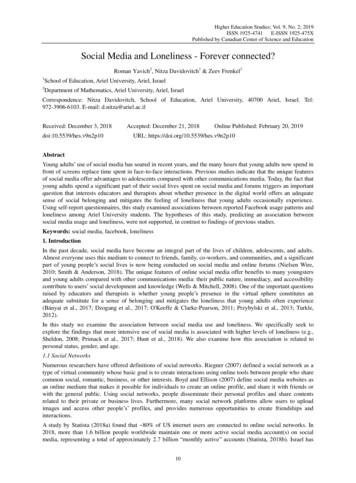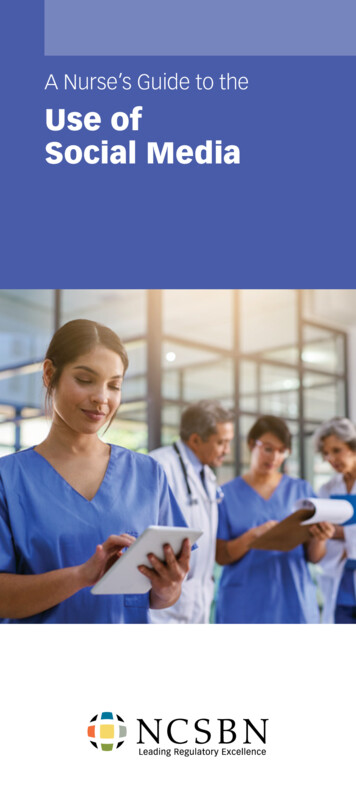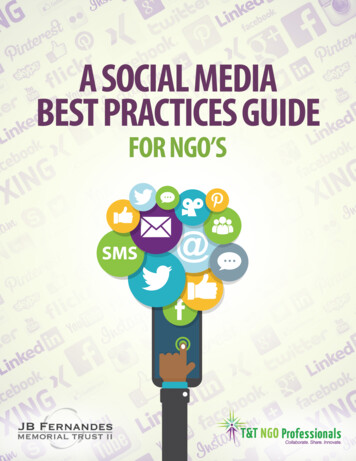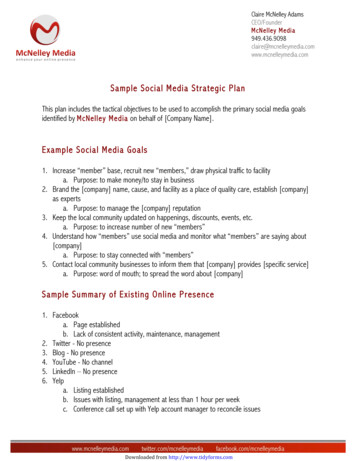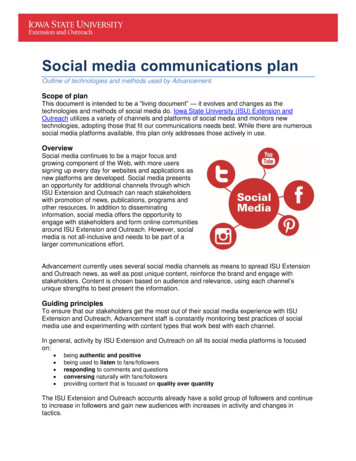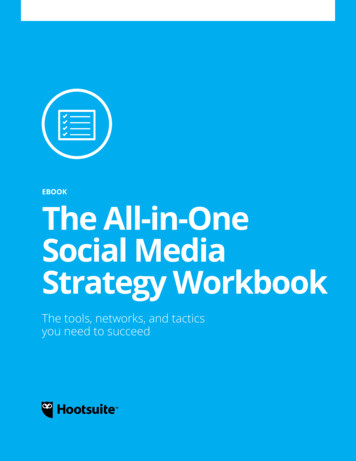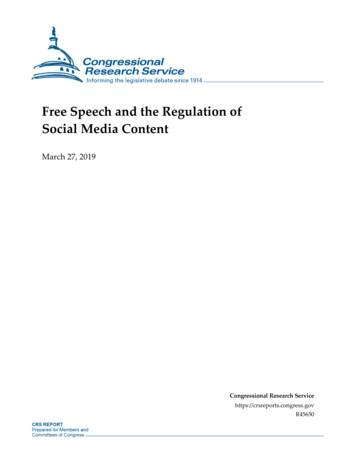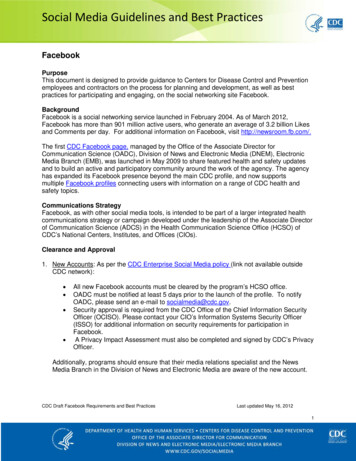
Transcription
Social Media Guidelines and Best PracticesFacebookPurposeThis document is designed to provide guidance to Centers for Disease Control and Preventionemployees and contractors on the process for planning and development, as well as bestpractices for participating and engaging, on the social networking site Facebook.BackgroundFacebook is a social networking service launched in February 2004. As of March 2012,Facebook has more than 901 million active users, who generate an average of 3.2 billion Likesand Comments per day. For additional information on Facebook, visit http://newsroom.fb.com/.The first CDC Facebook page, managed by the Office of the Associate Director forCommunication Science (OADC), Division of News and Electronic Media (DNEM), ElectronicMedia Branch (EMB), was launched in May 2009 to share featured health and safety updatesand to build an active and participatory community around the work of the agency. The agencyhas expanded its Facebook presence beyond the main CDC profile, and now supportsmultiple Facebook profiles connecting users with information on a range of CDC health andsafety topics.Communications StrategyFacebook, as with other social media tools, is intended to be part of a larger integrated healthcommunications strategy or campaign developed under the leadership of the Associate Directorof Communication Science (ADCS) in the Health Communication Science Office (HCSO) ofCDC’s National Centers, Institutes, and Offices (CIOs).Clearance and Approval1. New Accounts: As per the CDC Enterprise Social Media policy (link not available outsideCDC network): All new Facebook accounts must be cleared by the program’s HCSO office.OADC must be notified at least 5 days prior to the launch of the profile. To notifyOADC, please send an e-mail to socialmedia@cdc.gov.Security approval is required from the CDC Office of the Chief Information SecurityOfficer (OCISO). Please contact your CIO’s Information Systems Security Officer(ISSO) for additional information on security requirements for participation inFacebook.A Privacy Impact Assessment must also be completed and signed by CDC’s PrivacyOfficer.Additionally, programs should ensure that their media relations specialist and the NewsMedia Branch in the Division of News and Electronic Media are aware of the new account.CDC Draft Facebook Requirements and Best PracticesLast updated May 16, 20121
Social Media Guidelines and Best Practices2. Postings:Careful consideration should always be given to the nature of Facebook posts and activities. All Facebook posts and activities must be cleared through the clearance channelsdetermined by a program’s HCSO office. Facebook accounts are viewed as an official voice of CDC. Posts that are likely to draw widespread or media attention (e.g., new study shows20% increase in disease); reflect a change in policy, recommendations, or guidelines(e.g., CDC expands coverage recommendation for ABC vaccine); or address acontroversial topic may also need to be cleared through the program’s mediarelations specialist and the News Media Branch in the Division of News andElectronic Media. Posting standard health messages (e.g., exercise is good for you) should also gothrough a program’s communications clearance channels.BrandingIt is recommended that CDC Facebook pages include CDC in the page name and the CDClogo. Co-branding and the use of additional logos may also be incorporated in accordancewith CDC Brand Identity standards (link not available outside CDC network).Comment PolicyAn official comment policy should be developed for each Facebook page. An example CDCFacebook page comment policy is available in the application section of the CDC Facebookpage https://www.facebook.com/CDC/app 192223444203970.Records ManagementAll Facebook page administrators must establish a system to collect all Facebook posts,comments, fan posts, events, and hidden posts (spam) to comply with Federal guidelines forrecords management and archiving.Any comment removed for violating the CDC commenting policy must be recorded and archivedprior to deleting.ConsultationThe Electronic Media Branch (EMB) provides consultation on the planning and development ofFacebook activities and other social media tools. Please submit a Create-IT request (link notavailable outside CDC network) for Social Media Consultation. Your CIO’s Social Media Councilrepresentative (link not available outside CDC network) can also provide assistance.Planning RecommendationsBefore using Facebook, programs should consider the following recommendations whendeveloping communication plans:CDC Draft Facebook Requirements and Best PracticesLast updated May 16, 20122
Social Media Guidelines and Best Practices1. Clearly Define the Objectives: It is important to have clearly defined objectives beforeparticipating in Facebook. Do you want to highlight content, spark action, or encourageawareness of an issue? Clearly defined objectives will help you to determine if Facebookcan help you in meeting larger communication goals.2. Know Your Target Audience(s): As with any communications activity, it is important to defineyour intended target audience(s) in order to develop and communicate messages thatresonate with your audience and prompt them to take action.3. Determine Resource Needs: Determine if you have the appropriate staffing resources tocreate content and manage a Facebook page. It is important to designate a channelmanager to serve as the point of contact for Facebook activities and ensure the content isposted on a regular basis.4. Identify the Best Platform: Determine if you should develop a new Facebook page, havecontent posted on the CDC Facebook page, or use a different social media channel. SeeAppendix A, Channel Decision Matrix, for additional guidanceBest PracticesPrograms should consider the following best practices when developing Facebook content andactivities:1. Keep Your Content Short and Simple: Length of posts should be 250 characters or less to allow the post to be viewed inits entirety in the news feed.Length of comments should be 1,000 characters or less, and include a CDC.govlink for additional information and resources.2. Determine Schedule and Frequency of Facebook Posts: It is important to set a postingschedule that defines a regular frequency for posts per week. Setting a regular schedulehelps to ensure that the account is active and encourages more engaged users. Considerposting daily at a minimum.3. Identify the Best Web Link: All Facebook posts should include a single URL, preferably tothe CDC website or other CDC multimedia, to direct the user for more information.Campaign codes can be added to CDC.gov links in order to track metrics in Adobe SiteCatalyst.4. Add Custom Images: When posting CDC.gov Web links on Facebook, it is important thatweb pages are properly coded for enhanced display on Facebook. Please see Appendix B,Adding Custom Images for Facebook Posts, for additional guidance.CDC Draft Facebook Requirements and Best PracticesLast updated May 16, 20123
Social Media Guidelines and Best Practices5. Conduct Promotion Activities: Ongoing promotion of your Facebook page is stronglyrecommended. Example promotion activities include: Cross-promote on other CDC social media channels. Ask page owners of existingCDC Facebook pages and Twitter profiles with similar audiences and/or content topromote your Facebook activities. Post links to your Facebook page on your website. Send content-specific GovDelivery email updates. Send emails to partners and grantees.6. Determine Approach for Engaging with Facebook Fans: Facebook should be used toengage your target audience in two-way interaction and communication. Examples ofengagement activities include: Develop criteria for whom to Like and Tag on Facebook and share relevant partnercontent. See Appendix C, Best Practices for Liking and Commenting as the CDCBrand, for additional guidance. Post content that is actionable, such as Facebook chats, events, quizzes,contests/challenges, questions, videos, infographics, photos, badges, widgets andinteractive posts and comments on trending health topics to encourage followers toparticipate in conversations. Asks users to do something within the post or content such as Share, Like, orComment. Highlight posts that encourage CDC priorities and information sharing by pinning,highlighting or adding as a milestone on the Timeline. Post content that cross promotes other social media channels (e.g. Twitter,YouTube, Flickr) Post additional information rather than remove comments that are inaccurate or notreflective of CDC science. Removal of comments that are inaccurate or opinionated,but not in violation of the comment policy, may cause a lack of trust in the site andhas proven to be a practice that encourages backlash by the community. Monitor your Facebook page to respond as soon as possible to fan questions,comments and other feedback.7. Evaluation: Evaluation is an integral component for measuring the success of all socialmedia activities, including Facebook.Regularly review Facebook Insights for page-specific metrics. You may also considermonitoring the increases in traffic to your website, as well as the mentions outside ofFacebook on blogs, websites or articles.Adobe SiteCatalyst can be used to determine the number of click-throughs from a post witha link to a CDC.gov website. Automatically delivered metrics reports can be set-up forprograms upon request. For more information, please visit the Statistics and Metrics intranetCDC Draft Facebook Requirements and Best PracticesLast updated May 16, 20124
Social Media Guidelines and Best Practicessite (link not available outside CDC network).Highlighting Content on CDC’s Main Facebook PageThe Electronic Media Branch maintains the CDC Facebook Page, and welcomes programs touse it to highlight their content. Content is posted on the existing page 2-4 times per day on avariety of health and safety topics, and is moderated daily by EMB staff in accordance with theCDC comment policy.Requests to post on the main CDC Facebook page should be sent to socialmedia@cdc.gov oneweek in advance; however reasonable exceptions will be made in case of emergency.Submitted content must be cleared through a program’s established communications clearancechannels. If the topic is potentially controversial, identify a subject matter expert orcommunication specialist to help monitor Facebook comments on the day of posting. It is alsorecommended you draft and clear in advance possible responses and posts to additionalinformational for controversial topics.Posts should be 250 characters or less and include a single URL (e.g., CDC.gov, partner,government agency, etc.) photo, or video when possible. Metadata for CDC.gov URLs shouldbe included so that links and images properly display within Facebook.Creating a New CDC Facebook PagePlease submit a Create-IT request (link not available outside CDC network) to schedule aconsultation with EMB or contact your Social Media Council representative (link not availableoutside CDC network) for assistance.Visit http://www.facebook.com/government for additional resources about developing andmanaging government Facebook pages and to see what other agencies are doing. SeeAppendix D for additional requirements for Facebook Timeline.1. Develop and Clear a Facebook Concept, Plan, and Content: All Facebook activities,including account set-up and content creation, must be cleared through your CIO’sestablished communications clearance channels.Security approval is also required from the CDC OCISO for new and existing Facebookaccounts. Please contact your CIO’s ISSO for additional information on securityrequirements for participation in Facebook. A Privacy Impact Assessment must becompleted and signed by CDC’s Privacy Officer.OADC is required to maintain a directory of all CDC social media channels and must benotified at least 5 days prior to the launch of the profile. To notify OADC, please send ane-mail to socialmedia@cdc.gov. The program’s media relations specialist and the NewsMedia Branch in the Division of News and Electronic Media should also be made awareof the new account.CDC Draft Facebook Requirements and Best PracticesLast updated May 16, 20125
Social Media Guidelines and Best Practices2. Create the Facebook Page:Basic information required to establish a new Facebook Page:o Page name: A unique page name that describes the subject matter of theaccount, name of the organization or contains a keyword describing the nature ofthe organization. It is recommended that the profile name and page URL includeCDC (e.g., CDC Emergency Preparedness and Response, CDC Health PartnersOutreach).o List of page administrators: One to two individuals who will serve as pageadministrators and have the authority to post on behalf of the page (topic). It isrecommended to add SocialMedia@cdc.gov as an administrator to assist in pagesetup and to assist in the event of an emergency.o Basic information content: Location, general description and mission, as well as alist of web links (e.g., http://www.cdc.gov).o Disclaimer language in the About section: “For official CDC info go towww.cdc.gov. Disclaimer: Posted comments do not necessarily represent theviews of CDC.”Cover and Profile Images: A logo and image that represents your organization(see Branding information: link not available outside CDC network).It is recommended that the launch plan include a soft, internal-only launch to build yourfan base to 25. Once a page has 25 fans, you can claim your custom page URL andbegin a larger promotion effort (https://www.facebook.com/username/).Facebook ads must be removed from the page prior to external launch, as negotiatedunder the federal Terms of Service. Please send your request for ad removalto socialmedia@cdc.gov.3. Evaluate and Track Facebook Metrics: Establish a plan for monitoring and evaluatingyour Facebook presence. If you wish to use Adobe SiteCatalyst to track click-throughs,please visit the statistics and metrics intranet site (link not available outside CDCnetwork) for more information.CDC Draft Facebook Requirements and Best PracticesLast updated May 16, 20126
Social Media Guidelines and Best PracticesAppendix A: Social Media Channel Decision Matrix Use Existing Agency ChannelsCreate New Topic-based ChannelsPrimary GoalsPrimary GoalsCreate awareness, inform, disseminate,promote or provide newsGenerate “buzz”Expand reach Audience – General and Broad Largely consumer audience, general partnersand media (with similar messages to all groups)Target audiences already present on CDC’smain channel or other existing profilesNo ongoing relationship with the same audiencerequired Content – General and Periodic General consumer and/or partner messagesMessages fit within existing CDC profilesMessages support short-term campaigns Engagement Need – Low to Medium Engaging is primarily to increase awareness,buzz, and reach.Less two-way engagements requiredNo clearly defined communication or promotionplan to engage or build new audiencesInsufficient resources to consistently engagewith audiencesCDC Draft Facebook Requirements and Best PracticesAdvocacy groups, strong community groups, ormediaVery active and engaged audience already usingsocial media (or likely to)CDC has realistic capacity to get their audience onthis profileContent – Targeted and Frequent Build a communityEngagement with audiencesExpansive calls to action that require ongoingengagementSocial media highly integrated into your healthcommunication planAudience – Specific and Defined Highly targeted to an audience or highly specific to acomplex campaignNiche topic combined with strong audience interest,and not available through other CDC channelsFrequent and engaging content postsMessages support long-term campaigns and areexpected to have high volumeSubstantial conversations already occurring in socialmedia on this topicEngagement Need – Medium to HighLevel of engagement not possibly on other profilesFacilitate and moderate open dialogueNeed to regularly listen and receive information fromyour audiencesAssociated with a multi-year integrated campaignwith heavy social media engagementPotential for strong networking already exists(partners using or considering SM to reach their ownaudiences, and the ability to leverage)Last updated May 16, 20127
Social Media Guidelines and Best PracticesAppendix B: Adding Custom Images for Facebook PostsFacebook obtains images randomly from the page in order to show an image when posting alist. Then the images are converted to 90px x 90px which for some images, which may makethe images difficult to view. A custom image(s) when posting links into the Facebook posts is abetter option since the ratio and size can be customized. Create a JPEG image that is 90 pixelsx 90 pixels. Facebook displays JPEG images better than other types of images but willaccommodate PNGs and GIFs.How to create custom images: Upload the image to the dev server and the link server.Add code to the head of the page right after the description: meta name "medium" content "image" / meta property "og:image" content "http://www.cdc.gov/[IMAGELOCATION]" / meta property "og:title" content "CDC - [Name of Page]" / meta property "og:url" content "http://www.cdc.gov/[Page URL]"/ meta property "og:description" content "[Description]/ meta property "og:type" content "website" / meta property "og:image:type" content "image/jpeg" / meta property "og:image:width" content "90" / meta property "og:image:height" content "90" / CDC Draft Facebook Requirements and Best PracticesLast updated May 16, 20128
Social Media Guidelines and Best Practices Change the items that are in brackets [ ].If using a different type of image other than JPEG, then change the image type codeabove.Save and upload the page to the server.Once live, test the page in Facebook by adding the link. It is not necessary to click “post”in order to see if the image is working correctly.If the image is not showing, try to re-cache/refresh the page. Use the Facebook Debugger to debug theURL: https://developers.facebook.com/tools/debugEnter the URL that needs to be tested.Hit DebugThis page shows you how Facebook now sees your pageClose down Facebook.com and reopenAdd the URL in the status update to see the refreshed page postIf more images are required, add multiple lines of this code with the different image links. meta property "og:image" content "http://www.cdc.gov/[IMAGE LOCATION]" / Do not upload images to an https folder as Facebook will not recognize the images.Additional References: ughttp://ogp.me/CDC Draft Facebook Requirements and Best PracticesLast updated May 16, 20129
Social Media Guidelines and Best PracticesAppendix C: Best Practices for Liking and Commenting as the CDC BrandOverviewThis section includes best practices and recommendations for liking other Facebook pages,displaying “featured likes,” liking status updates or comments, commenting on partners’ contentas ‘the CDC brand’ and ways to cross-promote partner content. Please consult with your HCSOand other key stakeholders prior to “Liking” or “Commenting” as the CDC brand to determine theclearance process.Programs should determine, in conjunction with their CIO’s HCSO and other key stakeholders,which partners, agencies, and influencers to “Like” and engage with on Facebook. Specificsectors to consider when determining who to “like” can include other government agencies;CDC-funded public health partners, such as APHA and NACCHO; state and local healthdepartments; and non-profit public health organizations and partners (e.g., American CancerSociety).DefinitionsBrand: All CDC-branded Facebook pages owned by the CDC and managed by employeesor contractors.Tagging: Tagging is a function within Facebook available to page administrators. Taggingrefers to the action of cross-linking within a post to another CDC Facebook page or to anexternal partner page.Like (of a status update or comment): The “Like” occurs when a fan clicks on the “Likebutton” within a post to give positive feedback or support items.Displaying “Featured Likes” on your Agency Facebook PageFeatured Likes are a way for pages to permanently highlight or feature partner pages in theFacebook Timeline. “Liking” other featured partner organizations allows the CDC brand topromote partner content to fans of the CDC’s page for a one-time event (such as during anawareness month) or an extended period of time. This feature also encourages partners tocross-promote CDC Facebook pages and content.CDC Draft Facebook Requirements and Best PracticesLast updated May 16, 201210
Social Media Guidelines and Best PracticesExample of Facebook Featured LikesRecommendationsIt is recommended that all Facebook pages at CDC “like” other CDC Facebook pages by addingthem to the list of favorite pages. It is also recommended that other CDC Facebook pages areadded as “featured likes” as appropriate with respect to content. As the CDC brand, it is recommended to “like” public health partners who are onFacebook and encourage them to tag CDC in their posts on related topics. Public healthpartners can include federal agencies (e.g., AIDS.gov), and partners who are doing workwith related health topics (e.g., NFL – concussions) or campaigns (e.g.,ChildHealth.org). Other partners may also be highlighted as appropriate with clearancefrom your Health Communication Science Office (HCSO). It is recommended to contact approved partners and request they add your Facebookpage as a “Favorite Page,” especially if the CDC brand “likes” their page. To manage the CDC brand’s “like” list, the administrator can manually default the top 5featured partner organizations to show up in the Facebook timeline and rotate whichpartners show up during awareness months or campaign launches.Liking Status Updates or CommentsBy clicking on the “Like” button as the CDC brand, this indicates your brand page is supportingthe content or message of the post (for example, CDC Heads Up or CDC Tobacco Free may“like” the features, press releases, etc. that are posted on the main CDC Facebook page ontheir topic areas). The recipient of the “Like” action will also be notified. Liking status updates isnot restricted to CDC content, and can occur on partner pages as well.CDC Draft Facebook Requirements and Best PracticesLast updated May 16, 201211
Social Media Guidelines and Best PracticesRecommendations for Commenting on Partner ContentCommenting as a CDC branded page is a unique tool that allows programs to interact andengage in conversations with partners beyond the CDC brand page. Establish an internal process for when and how to comment as the CDC brand onpartner pages. Make sure comments are cleared through the appropriate channels. Commenting as theCDC brand on an external page requires clearing both content and context (page andthread) where the post will live. When commenting as the CDC brand, it is possible to positively influence theconversation, establish authority and credibility, correct misinformation, educate targetaudiences, raise awareness for prevention efforts, support partner events, and promotethe brand’s page. Remember any comment, whether it is on the CDC brand’s page or a partner pagerepresents the official position of the CDC.Ways to Cross-Promote Partner ContentPromoting partner content provides the opportunity for the CDC brand to expand the reach of itscontent through partner networks. It also provides the CDC brand the opportunity to collaboratewith key prevention partners by highlighting their messages and activities.“Liking” PartnersIn order for a CDC-branded page to comment or post on the wall of a partner’s page, theadministrator has to “Like” the partner page.CDC Draft Facebook Requirements and Best PracticesLast updated May 16, 201212
Social Media Guidelines and Best PracticesSharing Partner Content with the Fans of the CDC Brand PagesAfter “Liking” a partner’s page, the CDC Facebook page can share and feature posts frompartner pages. Click the “Share” button on the partner’s post you wish to share. These postsdisplay on the CDC brand page, as shown below:Encouraging Partner’s to Tag CDC Brand PagesWrite posts for partner pages about events, awareness activities, campaigns or resources beinglaunched. In order to tag another Facebook page, you must “Like” the page.Notify partner organizations of outreach plans prior to launch and create messaging consistentwith the partner’s page.CDC Draft Facebook Requirements and Best PracticesLast updated May 16, 201213
Social Media Guidelines and Best PracticesFinal Considerations Does the benefit of participating in the comment thread as the CDC brand on a partnerpage outweigh the risk of attracting unwanted, negative traffic or interaction to the CDCbrand’s wall? Be aware when participating on the thread to not appear to take sides with one strategicpartner at the expense of possibly alienating another. Featuring partners may open the CDC brand up to receiving requests from other pages,not necessarily partners. Decide how the CDC brand will handle these requests prior tofeaturing campaign or topic specific partner pages.CDC Draft Facebook Requirements and Best PracticesLast updated May 16, 201214
Social Media Guidelines and Best PracticesAppendix D: Requirements for Facebook TimelineCover PhotoTimeline’s cover photo allows you to create a descriptive visual of the CDC brand. The coverphoto image size is 851 x 315 pixels. It is recommended to refresh the image occasionally tocoordinate with campaigns or other events. The cover photo cannot include contact information(i.e. website, email, mailing address), calls to action, and references to Facebook features (i.e.like, share) or arrows pointing to these features. Images must be cleared through the clearancechannels determined by a program’s HCSO office.Profile ImageThis image represents CDC’s brand’s identity and should remain fixed. Co-branding and the useof additional logos may also be incorporated in accordance with CDC Brand Identitystandards (link not available outside CDC network). The profile picture image size is 160 x 160pixels and will sit at 23 pixels from the left and 210 pixels from the top. Images must be clearedthrough the clearance channels determined by a program’s HCSO office.About SectionThe About section provides basic and contact information for the CDC and is visible below theprofile image. It includes information entered into the “Basic Information” section of the profile.This section should include at a minimum the description or mission of the CDC, the CDCdisclaimer, and contact information. There is a 150 character maximum for the descriptive text.MilestonesA milestone is a major event that is particularly relevant to the CDC, such as a campaignlaunch, historical events, reaching a certain number of fans, or other moment that is significantto CDC’s growth and development. The photo image size for milestones is 843 x 403 pixels.The first milestone should be the date the CDC organization was founded. You cannot includemilestones before your organization’s founding date. Milestone images and content must becleared through the clearance channels determined by a program’s HCSO office.Pin PostsA pin post is a post that a brand may “pin” to the top of the Timeline for 7 days at a time as away to highlight important posts and links to increase engagement with fans. When running acampaign or event, pin a post that calls attention to the promotion.Star StoriesHighlight an important post on Timeline by “starring” it. When a post is starred, it will expand towidescreen and always be visible. Milestones cannot be starred.ApplicationsApplications, or apps, are featured below the cover photo. There are four apps featured on thetop Facebook navigation. Three apps can be customized; the photos app cannot be modified.Since featured apps are always visible to users who visit your Timeline, you should choosethem strategically. To see additional apps, users must expand the panel by clicking a drop-downbox located in the top navigation. Up to 12 apps are available on a Facebook page.CDC Draft Facebook Requirements and Best PracticesLast updated May 16, 201215
Social Media Guidelines and Best PracticesThe image size for apps is 111 x 74 pixels in size. Assign names to applications that clearlyindicate the content to users. Page app width can be set to narrow (520 pixels) or wide (810pixels).Direct MessagesTimeline gives fans the ability to send private, direct messages to brand pages. Timeline doesnot provide the ability to direct message fans or other users. It is recommended that this featurebe disabled for CDC Facebook pages unless a protocol for responding to inquiries has beenestablished.Administration PanelThe administration panel gives Facebook administrators access to page and post performance.Administrators can view notifications, page insights, direct messages and the activity log. Theactivity log provides a list of all posts and allows administrators to filter stories by type or byyear. Within the activity log the administrator can also star, hide, or delete stories and changethe date of a post so that it appears on the page Timeline with a more accurate date stamp.CDC Draft Facebook Requirements and Best PracticesLast updated May 16, 201216
May 16, 2012 · for additional resources about developing and managing government Facebook pages and to see what other agencies are doing. See Appendix D for additional requirements for Facebook Timeline. 1. Develop and Clear a Facebook Concept, Pla




